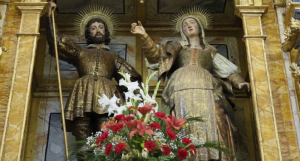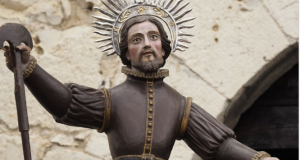Beleived to have been born in 1079, Saint Isidore the Farmer, known as the patron saint of farmers and rural communities, has grown into a culturally significant saint in agrarian areas worldwide. This is especially notable in North America, where devotion to him has spawn churches, organizations, and an emphasis on hard work.
While there may be no common religion across the U.S. countryside, Christianity as a whole does dominate the rural landscape. Yet even that can be broken down into regional clusters: In the South you’re likely to see Baptists and Methodists, while Lutherans are big in the Dakotas, and Catholics are prominent in the Upper Midwest. It’s in that last region where we find the most recognition of Saint Isidore the Farmer.
Not to be confused with another Saint Isidore, who was the bishop of Seville, Spain, the farming community’s Isidore (also from Spain) was deeply entwined with food production, working the land and helping to feed the poor as well as in taking especially good care of animals.
May 15 is the Catholic Church’s special day of adoration for Saint Isidore the Farmer (known as San Isidro in Spanish). Here are five things to know about him:
St. Isidore the Farmer, the Patron Saint of Farmers and Rural Communities

1. Exploring his life and work
Saint Isidore was born in the 11th century in Madrid, Spain, and as soon as he was old enough to hold farming tools, he began his life as a laborer on a farm. Isidore arose early every morning to go to church, though he sometimes rubbed his fellow workers the wrong way — they complained about him showing up late to the fields because of him lingering at church. Despite that, Isidore eventually rose to manager of the farm estate at which he worked.

2. He was married to another saint
Isidore wedded Maria Torriblia, also known as Maria de la Cabeza. The couple had one son, Illan, who died in infancy. The couple have long been recognized as a strong example of the vocation of marriage. It is not known in what year Maria died, but we know she went on to outlive Isidore, who died sometime around 1130.

3. Isidore was well known for his charitable acts
Both Isidore and Maria were known as givers to the poor, sharing necessities with neighbors and those less fortunate. Some of the historical accounts of Isidore even recount him supplying the poor miraculously with food. Isidore is also known for being especially concerned about the treatment of animals.

4. There is a deep respect for him in many nations
Not only is Isidore the patron saint of farmers, but he is also a patron of the cities of Madrid and of La Ceiba, Honduras. Additionally, agriculturally driven nations such as Costa Rica are heavily populated with churches under the name of San Isidro Labrador (Saint Isidore the Laborer), and he is highly revered there. In 1769, Charles III of Spain had the remains of Isidore and his wife relocated to the San Isidro Church in Madrid, where they could be close to those in need.

5. Being proclaimed a saint
One source says that 438 miracles have been attributed throughout history to Isidore’s intercession. Isidore was canonized in 1622 by the Catholic Church, and in 1947, he was proclaimed the patron of the United States National Rural Life Conference. Many images today depict him as a peasant holding a sickle, a staff, or a sheaf of corn.
Each year, people on Twitter mention and honor Saint Isidore on this day:
Happy feast of St. Isidore, patron saint of St. Isidore Church, #GRMI, and farmers, laborers and rural communities.
Pray here with Fr. Tom Simons, pastor of Holy Trinity Parish, as he blesses farmers and all those who bring food to our tables: https://t.co/7ekXHNn0aA
— Grand Rapids Diocese (@GRDiocese) May 15, 2020
Feast of Saint Isidore, patron of farmers, and the date my family traditionally planted corn. I’ll be planting Dakota Black Popcorn and Soltera Morado sweet corn. Also some Burmese okra today. Soil temps a little below average for sure, but should boom after Monday.
— Matthew Dillon (@_MatthewDillon) May 15, 2020
Today we honour the #FeastDay of St. Isidore, the patron Saint of farming. #ocsbFaith #ocsbAtHome pic.twitter.com/Pb7EPw29iJ
— Ottawa Catholic School Board (@OttCatholicSB) May 15, 2020
If you have a special devotion to Saint Isidore, there are various pieces of jewelry and other things that you can have to honor this saint. We’ve seen many family members wearing a necklace like this one, sometimes even with inscriptions on the back. Some necklaces come with prayer cards as well. Or, something a little more fun and off the cuff, this T-shirt may make you smile. There’s also the classic statuette of Saint Isidore for a room in your house or your barn.


